Arne Roennau
FZI Research Center for Information Technology, Machine Intelligence and Robotics Lab at the Karlsruhe Institute for Technology
LAURON VI: A Six-Legged Robot for Dynamic Walking
Aug 11, 2025Abstract:Legged locomotion enables robotic systems to traverse extremely challenging terrains. In many real-world scenarios, the terrain is not that difficult and these mixed terrain types introduce the need for flexible use of different walking strategies to achieve mission goals in a fast, reliable, and energy-efficient way. Six-legged robots have a high degree of flexibility and inherent stability that aids them in traversing even some of the most difficult terrains, such as collapsed buildings. However, their lack of fast walking gaits for easier surfaces is one reason why they are not commonly applied in these scenarios. This work presents LAURON VI, a six-legged robot platform for research on dynamic walking gaits as well as on autonomy for complex field missions. The robot's 18 series elastic joint actuators offer high-frequency interfaces for Cartesian impedance and pure torque control. We have designed, implemented, and compared three control approaches: kinematic-based, model-predictive, and reinforcement-learned controllers. The robot hardware and the different control approaches were extensively tested in a lab environment as well as on a Mars analog mission. The introduction of fast locomotion strategies for LAURON VI makes six-legged robots vastly more suitable for a wide range of real-world applications.
Cleaning Robots in Public Spaces: A Survey and Proposal for Benchmarking Based on Stakeholders Interviews
Jul 23, 2024Abstract:Autonomous cleaning robots for public spaces have potential for addressing current societal challenges, such as labor shortages and cleanliness in public spaces. Other application domains like autonomous driving, bin picking, or search and rescue have shown that benchmarking platforms and approaches in competitive settings can advance their respective research fields, resulting in more applicable systems under real-world conditions. For this paper, we analyzed seven semi-structured, qualitative stakeholder interviews about outdoor cleaning, identified current needs as well as limitations, and considered those results for the development of a benchmarking scenario based on the previous observations.
Behavior Tree Capabilities for Dynamic Multi-Robot Task Allocation with Heterogeneous Robot Teams
Feb 05, 2024



Abstract:While individual robots are becoming increasingly capable, with new sensors and actuators, the complexity of expected missions increased exponentially in comparison. To cope with this complexity, heterogeneous teams of robots have become a significant research interest in recent years. Making effective use of the robots and their unique skills in a team is challenging. Dynamic runtime conditions often make static task allocations infeasible, therefore requiring a dynamic, capability-aware allocation of tasks to team members. To this end, we propose and implement a system that allows a user to specify missions using Bheavior Trees (BTs), which can then, at runtime, be dynamically allocated to the current robot team. The system allows to statically model an individual robot's capabilities within our ros_bt_py BT framework. It offers a runtime auction system to dynamically allocate tasks to the most capable robot in the current team. The system leverages utility values and pre-conditions to ensure that the allocation improves the overall mission execution quality while preventing faulty assignments. To evaluate the system, we simulated a find-and-decontaminate mission with a team of three heterogeneous robots and analyzed the utilization and overall mission times as metrics. Our results show that our system can improve the overall effectiveness of a team while allowing for intuitive mission specification and flexibility in the team composition.
Efficient Gesture Recognition on Spiking Convolutional Networks Through Sensor Fusion of Event-Based and Depth Data
Jan 30, 2024



Abstract:As intelligent systems become increasingly important in our daily lives, new ways of interaction are needed. Classical user interfaces pose issues for the physically impaired and are partially not practical or convenient. Gesture recognition is an alternative, but often not reactive enough when conventional cameras are used. This work proposes a Spiking Convolutional Neural Network, processing event- and depth data for gesture recognition. The network is simulated using the open-source neuromorphic computing framework LAVA for offline training and evaluation on an embedded system. For the evaluation three open source data sets are used. Since these do not represent the applied bi-modality, a new data set with synchronized event- and depth data was recorded. The results show the viability of temporal encoding on depth information and modality fusion, even on differently encoded data, to be beneficial to network performance and generalization capabilities.
HoLLiE C -- A Multifunctional Bimanual Mobile Robot Supporting Versatile Care Applications
Dec 11, 2023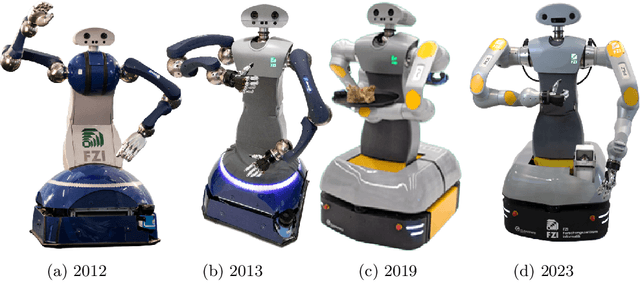

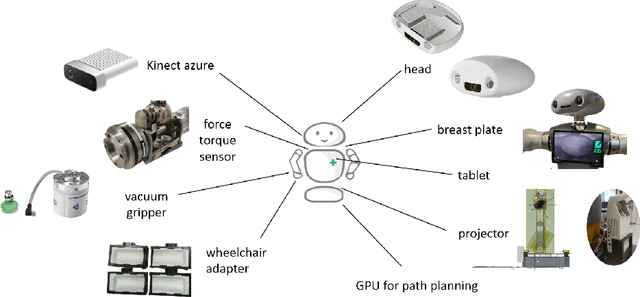

Abstract:Care robotics as a research field has developed a lot in recent years, driven by the rapidly increasing need for it. However, these technologies are mostly limited to a very concrete and usually relatively simple use case. The bimanual robot House of Living Labs intelligent Escort (HoLLiE) includes an omnidirectional mobile platform. This paper presents how HoLLiE is adapted, by flexible software and hardware modules, for different care applications. The design goal of HoLLiE was to be human-like but abstract enough to ensure a high level of acceptance, which is very advantageous for its use in hospitals. After a short retrospect of previous generations of HoLLiE, it is highlighted how the current version is equipped with a variety of additional sensors and actuators to allow a wide range of possible applications. Then, the software stack of HoLLiE is depicted, with the focus on navigation and force sensitive intention recognition.
Distributed Behavior Trees for Heterogeneous Robot Teams
Sep 15, 2023



Abstract:Heterogeneous Robot Teams can provide a wide range of capabilities and therefore significant benefits when handling a mission. However, they also require new approaches to capability and mission definition that are not only suitable to handle heterogeneous capabilities but furthermore allow a combination or distribution of them with a coherent representation that is not limiting the individual robot. Behavior Trees offer many of the required properties, are growing in popularity for robot control and have been proposed for multirobot coordination, but always as separate behavior tree, defined in advance and without consideration for a changing team. In this paper, we propose a new behavior tree approach that is capable to handle complex real world robotic missions and is geared towards a distributed execution by providing built in functionalities for cost calculation, subtree distribution and data wiring. We present a formal definition, its open source implementation as ros_bt_py library and experimental verification of its capabilities.
Learning Human-Inspired Force Strategies for Robotic Assembly
Mar 22, 2023



Abstract:The programming of robotic assembly tasks is a key component in manufacturing and automation. Force-sensitive assembly, however, often requires reactive strategies to handle slight changes in positioning and unforeseen part jamming. Learning such strategies from human performance is a promising approach, but faces two common challenges: the handling of low part clearances which is difficult to capture from demonstrations and learning intuitive strategies offline without access to the real hardware. We address these two challenges by learning probabilistic force strategies from data that are easily acquired offline in a robot-less simulation from human demonstrations with a joystick. We combine a Long Short Term Memory (LSTM) and a Mixture Density Network (MDN) to model human-inspired behavior in such a way that the learned strategies transfer easily onto real hardware. The experiments show a UR10e robot that completes a plastic assembly with clearances of less than 100 micrometers whose strategies were solely demonstrated in simulation.
Reactive Neural Path Planning with Dynamic Obstacle Avoidance in a Condensed Configuration Space
Jul 08, 2022



Abstract:We present a biologically inspired approach for path planning with dynamic obstacle avoidance. Path planning is performed in a condensed configuration space of a robot generated by self-organizing neural networks (SONN). The robot itself and static as well as dynamic obstacles are mapped from the Cartesian task space into the configuration space by precomputed kinematics. The condensed space represents a cognitive map of the environment, which is inspired by place cells and the concept of cognitive maps in mammalian brains. The generation of training data as well as the evaluation were performed on a real industrial robot accompanied by simulations. To evaluate the reactive collision-free online planning within a changing environment, a demonstrator was realized. Then, a comparative study regarding sample-based planners was carried out. So we could show that the robot is able to operate in dynamically changing environments and re-plan its motion trajectories within impressing 0.02 seconds, which proofs the real-time capability of our concept.
A Walking Space Robot for On-Orbit Satellite Servicing: The ReCoBot
Mar 19, 2022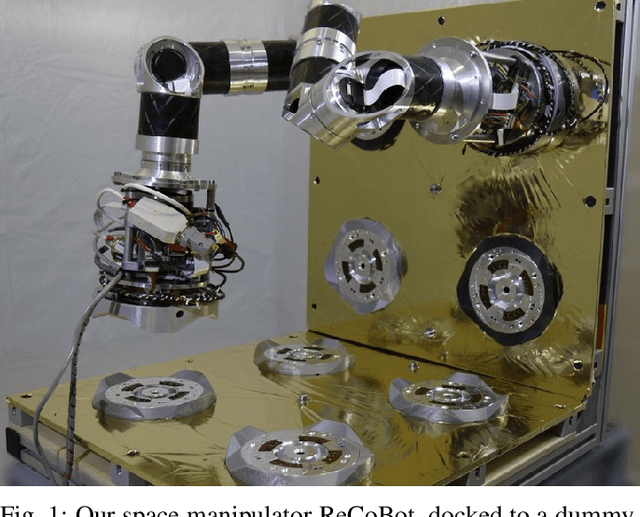
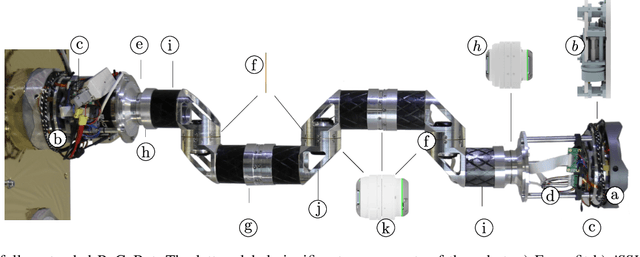
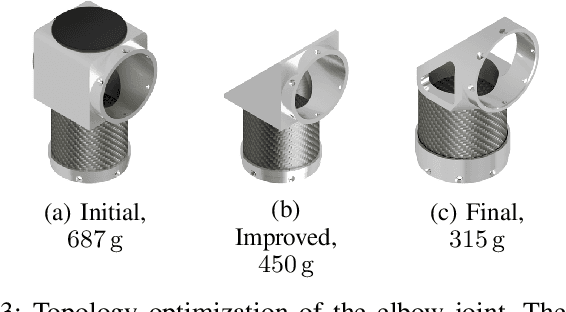
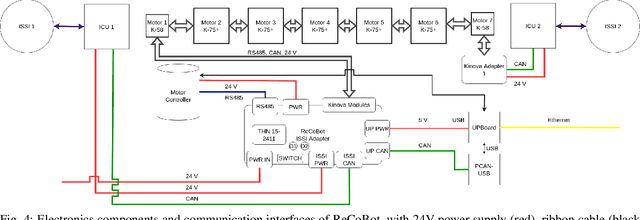
Abstract:A key factor in the economic efficiency of satellites is their availability in orbit. Replacing standardized building blocks, such as empty fuel tanks or outdated electronic modules, could greatly extend the satellites' lifetime. This, however, requires flexible robots that can locomote on the surface of these satellites for optimal accessibility and manipulation. This paper introduces ReCoBot, a 7-axis walking space manipulator for locomotion and manipulation. The robot can connect to compatible structures with its symmetric ends and provides interfaces for manual teleoperation and motion planning with a constantly changing base and tip. We build on open-source robotics software and easily available components to evaluate the overall concept with an early stage demonstrator. The proposed manipulator has a length of 1.20 m and a weight of 10.4 kg and successfully locomotes over a satellite mockup in our lab environment.
Comparing SONN Types for Efficient Robot Motion Planning in the Configuration Space
Mar 18, 2022

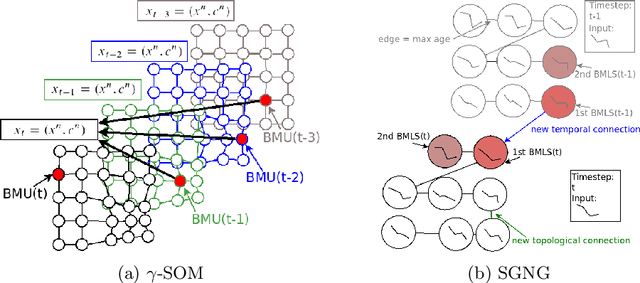
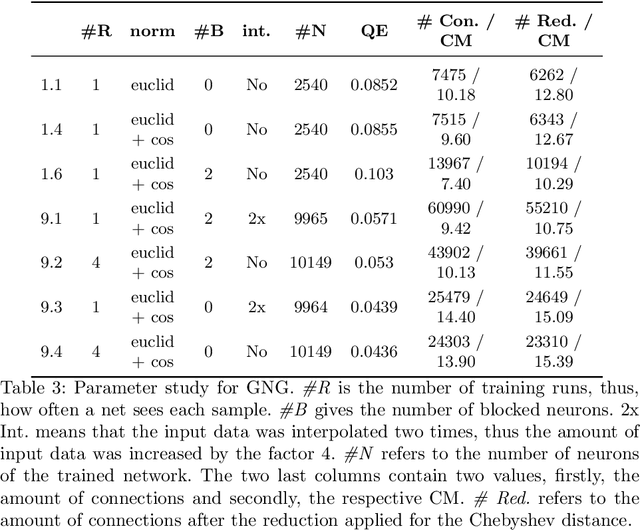
Abstract:Motion planning in the configuration space (C-space) induces benefits, such as smooth trajectories. It becomes more complex as the degrees of freedom (DOF) increase. This is due to the direct relation between the dimensionality of the search space and the DOF. Self-organizing neural networks (SONN) and their famous candidate, the Self-Organizing Map, have been proven to be useful tools for C-space reduction while preserving its underlying topology, as presented in [29]. In this work, we extend our previous study with additional models and adapt the approach from human motion data towards robots' kinematics. The evaluation includes the best performant models from [29] and three additional SONN architectures, representing the consequent continuation of this previous work. Generated Trajectories, planned with the different SONN models, were successfully tested in a robot simulation.
 Add to Chrome
Add to Chrome Add to Firefox
Add to Firefox Add to Edge
Add to Edge